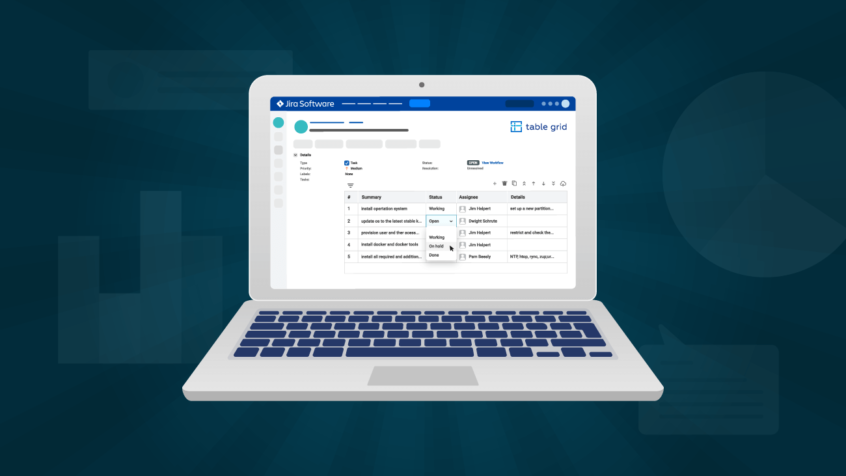We’re very excited to be announcing a new release of Table Grid Next Generation (TGNG).
It is now feature-complete compared to the old TGE. So we’re making it extra easy for you to migrate your data from TGE to the new TGNG using an app. We’ve also added brand new features: Driving Tables and Data Mirroring.
It’s Time to Migrate from TGE to TGNG
If you’re still using the Table Grid Editor, it’s time to start having a look at the new app, which comes with an improved UI, enhanced import/export functionality, REST and Java APIs and full-service desk support, among other features.
The Migration tool
To make it super easy for the existing TGE customers to migrate their Table Gird data, we’ve launched the Table Grid Migration Tool. This will enable you to migrate all of your data from TGE to TGNG in a few simple steps.

You’ll need:
- To convert your license, with a request to our support portal here, including your SEN number, license key, and contact email.
Note: The license conversion is only valid until April 2021, so don’t miss it!
- The Table Grid Next Generation app installed and updated to the latest version
- The Table Grid Editor app installed and updated to the latest version
- The Table Grid Migration Tool extension installed
- A Jira re-index performed
And then you can follow … You can read a complete guide to the process here.
TGNG Latest Feature Release
We’ve previously talked about some of the new functionality available for TGNG, such as Jira Value Placeholders, but the final pieces are now coming into place with Driving Tables and Data Mirror functionality. And you might say, we’ve saved the best for last!
Driving Tables – Create Stand-alone Tables
Driving Tables allow you to create stand-alone tables with data that isn’t connected to any issues in your system. Instead, you can use the driving table as a data source for your grid. You can also create a table, add data, and then export it to an external database and reuse it elsewhere. This powerful new functionality means that Table Grids can be used far more flexibly than ever before. 
You can read our full documentation on Driving Tables here.
Data Mirror – Save Grid Data into your Database
The Data Mirror feature allows you to save values from your Table Grid into your Jira database or into an external database (with grid values being stored by default in the custom field value table of the Jira database). All you need to do to make this happen is to connect a database and configure the data mirror. This makes it extremely fast and easy to pull data out of the system – and you’re then free to edit and manipulate the information as much as you need.

You can read our full documentation on Data Mirror functionality here.
Use Case
Let me walk you through a possible use case including both the Driving Table and the Data Mirror features. Let’s say you need to store the data regarding your products and services somewhere. Here comes the Driving Table to your aid as it’s easy to use due to its simple user interface. So you can store all your data in the Driving Table using it as a data source.
What’s more, is that you can also connect an external database to your Driving Table and copy the data from the Driving Table into the database. This is actually done by the Data Mirror feature.
You can now make a dynamic list of the products and their prices on the issue view. When you select a product from the drop-down list, the price is added automatically to the grid. You can get the price with the help of the JavaScript-based formula column type and the data from the Driving Table. Your sales team will then be able to use this very grid to create invoices for customers. That’d be very easy to do with Table Grid Next Generation since you can later export the data as a PDF or an excel file.
So in summary, you have a stand-alone table with the data that you can update using a simple interface. This data is mirrored to your external database, and you have a dynamic list of products which always displays the up-to-date details of the products.
Another use case is the internal purchase process that works the same way. A person manages the list of the usual needed products like laptops, keyboards, desks, and suchlike. Another person, the office manager for example, receives a ticket in Jira where they can see the grid with the list of what should be bought. This list can be exported and sent for approval to the person in charge, like the accountant or the team lead.
You can read more on this documentation page.
Conclusion
We speak to hundreds of customers every year, so we’re excited to be bringing brand new features and functionality to your Jira Table Grids, informed by feedback from teams of all sizes and across all sectors.
Whether you’re a TGE pro or are bringing Table Grids to Jira for the first time, you should now be ready to get started with Table Grid Next Generation with the Table Grid migration tool.
For this release, you’ll be able to enjoy our brand new features: Driving Tables and Data Mirror.
You can find Table Grid Next Generation here and the Table Grid Migration tool here.


